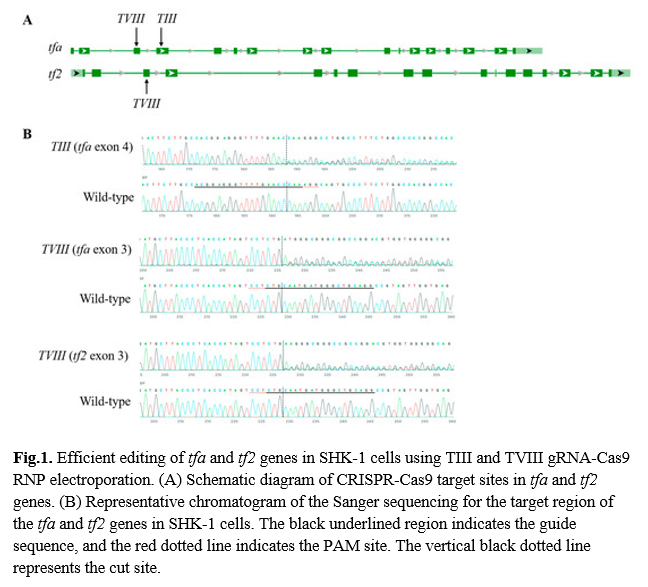TRANSFERRIN GENE KNOCKOUT REVEALS A TOLERANCE PHENOTYPE AGAINST Piscirickettsia salmonis IN ATLANTIC SALMON
Introduction
Iron metabolism plays a critical role in fish’s immune response against intracellular pathogens such as Piscirickettsia salmonis. Transferrin, a key iron transport protein, has emerged as a molecular target for improving disease tolerance. Here, we integrate findings from two complementary studies to evaluate the impact of transferrin gene knockout on transcriptional regulation and tolerance phenotypes in Atlantic salmon.
Methods
Transferrin knockout (TF-KO) in SHK-1 salmon cells was generated using CRISPR/Cas9 with two gRNA strategies targeting exon 3 and 4 of tfa and exon 3 of tf2 (Fig.1). RNA-seq performed transcriptomic analyses . In parallel, TF-KO lines were tested in vitro for cytopathic effects and bacterial burden upon P. salmonis infection. Field trials evaluated the correlation between vaccination, survival, and iron metabolism gene expression.
Results
TF-KO cells showed reduced cytopathic vacuole formation and higher survival after infection with P. salmonis, despite unchanged bacterial load. RNA-seq revealed differentially expressed genes unrelated to iron metabolism, but enriched in metal- and zinc-binding processes (e.g., MTF2, ZFAND4). In the field, vaccinated fish showed upregulation of iron metabolism genes, particularly transferrin and its receptor. Comparative transcriptomics confirmed enrichment of nuclear and cyto plasmic processes, GTPase activity, and mTOR signaling.
Discussion
These results suggest that transferrin gene disruption does not impair iron homeostasis but triggers broader transcriptional adaptations associated with metal homeostasis and immune tolerance. The integration of in vitro and in vivo approaches supports the role of transferrin as a key regulator of tolerance mechanisms in salmon facing bacterial infections.

